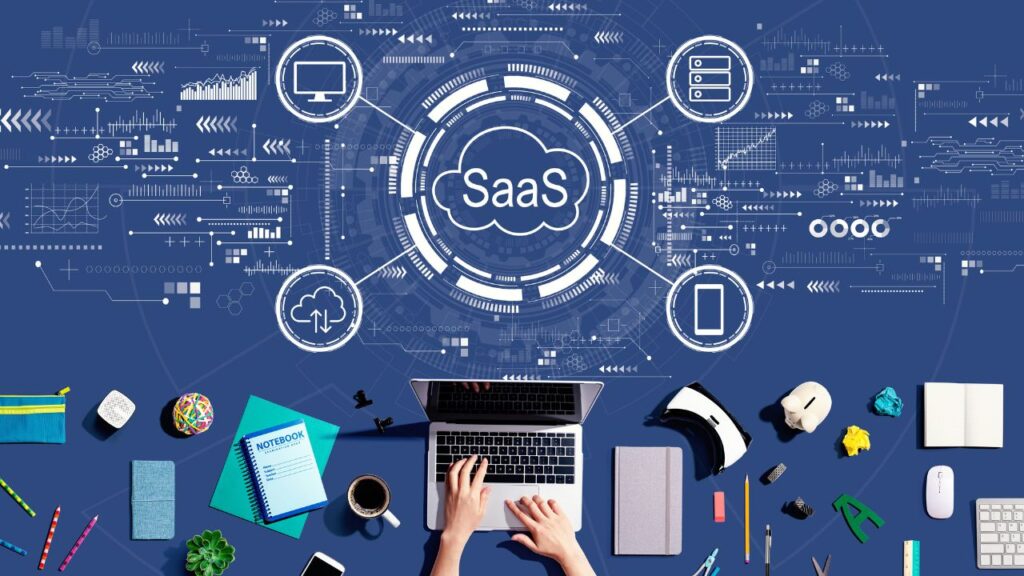What is Software as a Service in Cloud Computing? A Beginner’s Guide, now in the age of AI, cybersecurity, and cloud SaaS, is part of life.
SaaS stands for software as a service, used in our daily lives for any specific purpose. For example, Gmail, Microsoft Excel, Outlook, video calls with Zoom, Salesforce, and Dropbox are cloud storage services.

This article provides in-depth knowledge about the exact meaning of SaaS and examples of software used in our work. You may have used SaaS without even knowing it in today’s cloud-first world. SaaS apps are a part of daily life and work. You can use them to check your Gmail, manage projects in Trello or Slack, and more.
Index of Content:
- What does SaaS mean?
- What does SaaS mean in the cloud?
- How do SaaS apps work?
- Examples of SaaS that are common
- Why Use SaaS?
- Common Problems with SaaS Things to remember:
- What is the difference between SaaS and PaaS?
SaaS stands for? 1.) how it works, 2.) why it’s important in cloud computing, and 3.) how it differs from other cloud models like PaaS ?. We can help you, whether you’re new to technology or just want to learn the basics.
What does SaaS mean?
Software as a Service is what SaaS stands for. This is a way to deliver software where apps are stored in the cloud and users can access them over the internet, usually by paying a subscription fee.
You don’t have to download and install software on your computer; you just log in through a web browser. People often ask, What is SaaS in cloud computing? because of this. because the point is to run software straight from the cloud.
Instead of owning the software, think of it as renting it.
What does SaaS mean in the cloud?
In the world of cloud computing, SaaS is software that a third-party company takes care of completely. The provider takes care of everything, including servers, storage, updates, and security.
This is why SaaS is ideal for people or businesses that want software that is ready to use without having to deal with IT problems.
How do SaaS apps work?
Here’s a brief look at how a SaaS platform works:
- Hosting: The vendor’s cloud infrastructure is where the software is stored.
- Access: You can get to the software by using a browser or mobile app and logging in with a SaaS account.
- Data: Your data is safe in the cloud.
- Subscription: You pay once a month or once a year to use different features.
The provider takes care of updates, bug fixes, and backups as part of maintenance.
Examples of SaaS that are common
You probably didn’t know that many of these are SaaS:
- Gmail, Google Docs, and Google Drive are all part of Google Workspace.
- Microsoft 365, which includes Word, Excel, and Outlook
- Slack (for talking to your team)
- Video calls with Zoom
- Salesforce (for managing customer relationships)
- Dropbox is a cloud storage service.
These SaaS examples show how flexible and popular the model is, from email to file sharing to CRM.
Why Use SaaS?
Main Benefits:
- No installations: All you have to do is sign in and start using the software.
- Less expensive: No costs for hardware or licenses up front.
- Automatic Updates: Get the most recent version all the time.
- Remote Access: You can use it on any device that has an internet connection.
- Scalability: You can add users or features as you need them.
Common Problems with SaaS Things to Remember:
- Needs the Internet: You can’t use it offline, or it’s hard to get to.
- Data Control: We keep sensitive data separate.
- Customization: SaaS platforms might not let you change things in a big way.
- Costs of Subscriptions: Monthly fees can add up over time.
What is the difference between SaaS and PaaS?
SaaS and PaaS (Platform as a Service) are both types of cloud computing, but they do different things:
- Use Case for SaaS and PaaSApps for end users, like email and CRMTools for developers to make apps
- Access through a browser (with a SaaS login)Through APIs and development platforms
- ManagementProvider takes care of everythingYou take care of your apps, and the provider takes care of the platform.
- Zoom, Trello, Google Docs, Heroku, and Google App Engine are some examples.
If you just want software that “works,” go with SaaS. PaaS might be what you need if you’re making or changing software.
SaaS in 2025 and after
SaaS is changing quickly. In 2025, SaaS tools will use AI, automation, and real-time analytics to work. Companies are using SaaS platforms to make everything from marketing to HR easier. Students use them to take notes and work together. Creative people use them for design, video editing, and other things.
With more people using their phones, SaaS login systems are now safer and more flexible than ever, thanks to features like two-factor authentication and single sign-on (SSO).
How to Start Using SaaS: Make a List of What You Need Find out what you need help with, like email, keeping track of projects, customer service, etc.
- Look for SaaS apps that fit your needs by searching for them.
- Try Free Versions: A lot of SaaS platforms let you try them out for free or for a limited time.
- Check the Prices: Pick the subscription plan that fits your budget.
- Check for Integrations: Make sure the tool works with the software you already have.
Summary:
SaaS has changed how we work, learn, and use technology. SaaS platforms are a simple, adaptable, and cheap way for freelancers, students, and small business owners to get to powerful tools.
You now know what SaaS stands for, how it works in cloud computing, and the difference between SaaS and PaaS. Now you can look into and pick the best tools for your needs.
And don’t forget: you can use powerful features anytime, anywhere with just a SaaS login. I hope you enjoye the valuable knowledge at CityTechPlus.com
